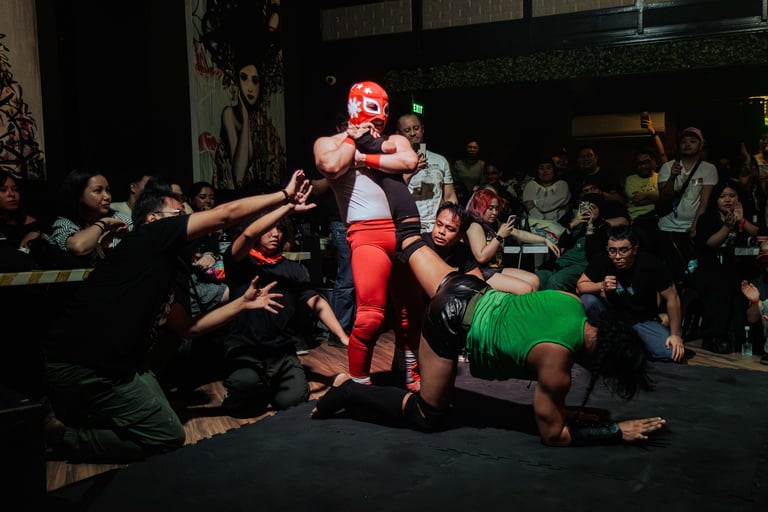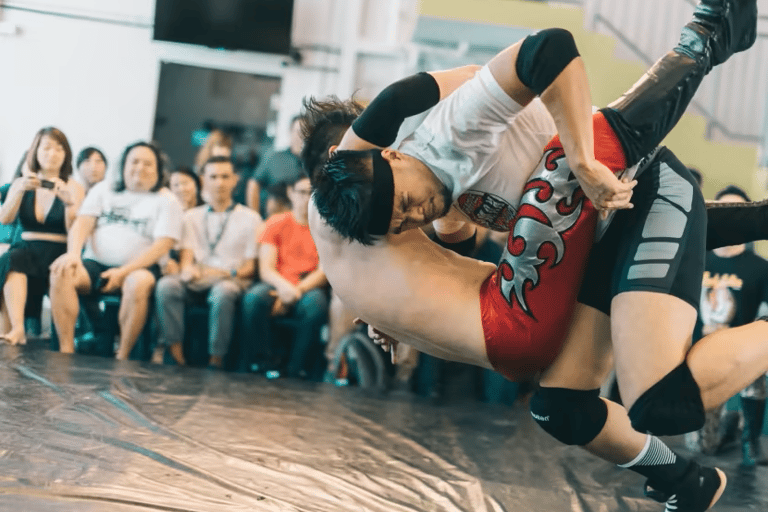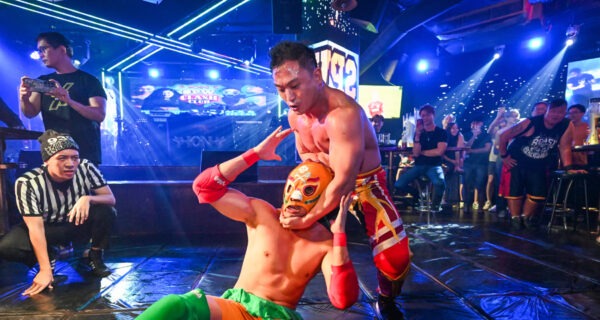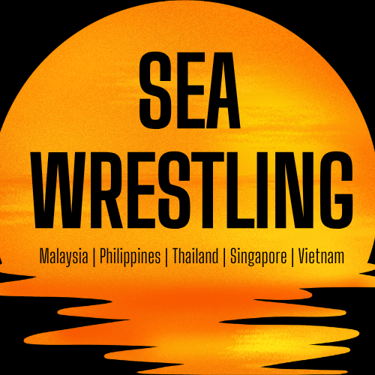On the Mats - The Influence of Mat Wrestling in Southeast Asia
Over the last decade, Southeast Asia’s alternative event format has gone from necessity to an emerging attraction. Read the full article now on SEA Wrestling
ARTICLES
Simon
10/4/20255 min read


On the Mat - Mat Wrestling in Southeast Asia
Over the last decade, Southeast Asia’s alternative event format has gone from necessity to an emerging attraction.
If you’re a Japanese puroresu fan, you might have seen that promotions such as the critically acclaimed Choco Pro are missing a key ingredient for a wrestling show. I’ll give you a clue: it’s big, has four posts, and three ropes. That’s right—promotions like Choco Pro choose to rarely use an actual professional wrestling ring and instead use wrestling mats. Think of something akin to a more padded martial arts mat to absorb higher impacts.
While fans of mainstream wrestling might find that an unusual adaptation from common conventions, this novel approach helped to shape the very story of some of Southeast Asia’s biggest wrestlers and promotions. Today, many still use the mats for select shows, not out of necessity but genuine fan demand.
As stated, many promotions started off using wrestling mats in lieu of being able to build a ring, be it due to financial reasons or lack of technical expertise. Although most well known as the quirky inhabitants of Ichigaya Chocolate Square in Tokyo, Choco Pro was actually founded as a partnership between Emi Sakura and now-SETUP Thailand promoter Prachapoom "Pumi" Boonyatud, with shows being held in both Tokyo and Bangkok from 2012. Originally branded as Bangkok Girls Pro Wrestling, the promotion would switch to Gatoh Move quickly and become popular in both countries as well as begin its journey to online sensation. The reason for the use of mats was primarily cost-based. Using a mat meant not paying out for a ring, where manufacturing a ring to enter a new market could have been a risky expense.
Although the promotion would shift to using a ring a few years later, it inspired a group of youngsters known as Saigon Pro Wrestling Club (the precursor to Vietnam Pro Wrestling). Started by a few young men looking to live out their wrestling dream by any means, their only option in the early days was to use a wrestling mat, as they had neither the money nor knowledge of how to get a ring built.


Numerous other promotions such as Grapplemax have a similar story. Grapplemax founders Greg Ho and Crypto Bro LK have both talked about the early days where an actual ring would have been redundant and a financial burden due to manufacturing, space, transportation and storage costs.
On top of the money and know-how to build a ring, mat shows allowed these promotions in their pioneering early days to select venues that would be cheaper to run and, in some cases, keep a lower profile when necessary. There was also the issue of safety. While a boxing ring or similar could be used as a pseudo-wrestling ring, the lack of padding and give could cause additional injury, especially to those with less training. The mat often provides even more safety than a conventional wrestling ring.
Far from being a hindrance, mat shows allowed wrestlers and promoters to think outside the box and try something new. Both Super P and Jake De Leon, on the Retro Wrestling Room Podcast, discussed how Puso and DEXCON’s use of mats for venues outside the Brawlpit allows them to experiment with unique moves and combinations that they then take back inside the squared circle. Not only does the new environment inspire creativity, but it can also be a necessity to wow those fickle fans disappointed not to have a ring in front of them.
Puso continues to offer up unique and exciting events throughout the year outside the Brawlpit using their mats. Although some have been events at conventions for publicity purposes, Headlocks & Headbangs took the idea to the next level. Integrating live music inside cool cocktail hangout Sari Sari created a unique party vibe to the show, which saw wrestlers, fans, and unsuspecting patrons get extremely close to the action. Dexcon recently followed this format with their own show, Baka Gaijin. Far from a pre-show to the ring-based Peksman a couple of days later, this mat show was a full-on event at another cool venue, the Social House, where the Pinoy wrestlers adapted to the Choco Pro style, making regular Chris Brookes feel very welcome.


One of the pioneers in Southeast Asia (and possibly the world) of the mat-based bar fight setting was Singapore Pro Wrestling who, although they typically use a ring, run their special Clash at the Club events annually at ION Club, which really must be seen to be believed. Unlike others where the wrestling is almost a special night off from the normal bar or club antics, CATC features some of Singapore's finest slugging it out in the middle of an active, full Asian club.
Some promotions, such as SETUP’s feeder system TOP Dojo, continue to hold all their events on mats the way Sakura intended back in 2012. Running a regular series of shows from the Motorway Dojo, Thai Origin Pro attracts a loyal fan base for their monthly mat-based events to see veterans such as Golem Thai square up with the newest of Thai wrestling recruits.
Perhaps the group utilising the mats in the most effective way is Grapplemax, who by the time of reading will have run three mat shows already this year. As part of the Pasar Pink festival they were situated in one of the main halls on a stage overlooking small craft stalls in a way that caught the attention of even the most avid shopper. Then, more recently, they took to Timbre North for Slam & Savour, an all-day event wrapped around mat-based matches. However, their most infamous mat-based series is Fightclub. Now in its 5th year, the show has moved from being true to the inspiration behind the name—in a dark, secret room difficult to find—to being held in the prestigious Projector cinema in front of 250 loud fans, where the promotion utilised cinematic elements to give the matches a special feeling for the evening.
I want to admit something. When I first saw Southeast Asian wrestling, almost a decade ago, I saw a mat show. I was turned off by the lack of convention—this wasn’t my wrestling. But I am willing to admit when I’m wrong. We can’t forget the mat show principle. Without it, the flourishing Southeast Asian scene wouldn’t be here today. We wouldn’t have the creative, skilled base of talent that we do, and promotions certainly wouldn’t be showing off that unique SEA Wrestling flair.
SEA Wrestling
Your source for Southeast Asia pro wrestling news.
CONTACT
contact@seawrestling.com


